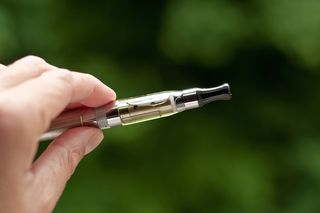Teens Use E-Cigarettes to 'Vape' Pot

Nearly one-fifth of high school students who use e-cigarettes have tried putting pot into the devices, according to a new study of Connecticut teens.
E-cigarettes vaporize, rather than burn, substances, allowing users to inhale nicotine (or THC, the active ingredient in cannabis) without taking in the carcinogens that are caused by combustion. However, the safety of vaping pot versus smoking it has not been well-established, the researchers write today (Sept. 7) in the journal Pediatrics. (Nor has the safety of using tobacco with e-cigarettes. Though cancerous combustion products aren't present, other carcinogens, such as formaldehyde, are.) Vaping cannabis oils or hash may release higher levels of THC than smoking dried leaves, the researchers wrote. And previous research has shown that THC might have negative effects on the developing teen brain.
While e-cig users in the study were at increased risk of vaping pot, few teens overall — just 5.4 percent — had used e-cigarettes to do this. However, the numbers were still surprising, said study researcher Meghan Rabbitt Morean, a psychologist at Oberlin College.
"The rates seemed pretty considerable, especially in a state where sale of e-cigarettes to minors is not legal, and also cannabis use is illegal," Morean told Live Science. [10 Facts Parents Should Know About the Teen Brain]
Vaping cannabis
E-cigarette use is on the rise among teenagers. According to the 2014 National Youth Tobacco Survey, 13.4 percent of teens had used e-cigarettes in the month prior to being surveyed, three times the level from the year before (4.5 percent).
Morean said she and her colleagues are running ongoing surveys of youth substance use in high schools and middle schools. In the course of conducting surveys — and in media reports — they'd heard "buzz" that teens were modifying e-cigarettes to use them for vaping marijuana, the researchers said. (There are also vape pens specifically manufactured for pot use.)
Sign up for the Live Science daily newsletter now
Get the world’s most fascinating discoveries delivered straight to your inbox.
The researchers decided to add some questions to their surveys of Connecticut high schoolers to explore the question. Of 3,847 students from five schools, 27.9 percent of the respondents said they had tried e-cigarettes at some point, the researchers found. Separately, 29.2 percent had tried marijuana. And 18.8 percent reported they had tried both e-cigarettes and marijuana at some point.
The researchers found that 26.5 percent of that last group, dubbed "dual users," said they'd used e-cigarettes for pot, which means that 18 percent of all e-cigarette users had used the devices for marijuana.
Stealthy smoking?
Among these dual users, 29 percent had vaped dried cannabis leaves, while 23 percent had used e-cigarettes to vaporize hash oil, a concentrated resin extract of marijuana, and 15 percent had used the devices to vape THC-infused wax, according to the researchers.
Hashes and oils can have THC concentrations up to 30 times higher than dried leaves, according to earlier research. But little is known about the health effects of vaping pot versus smoking it.
"There are a lot of questions that we don't have answers to," Morean said.
The researchers said they don't yet know whether e-cigarettes may lure teens to try pot, or whether the devices are just a new way to use marijuana for teens who would have smoked it anyway.
The researchers said they also don't know how frequently teens may vape pot, whether the Connecticut students reflect larger national trends, whether teens are buying devices specifically for marijuana or modifying e-cigarettes, or what else teenagers might be trying to vape.
It's possible, Morean said, that vaping pot appeals to teens in part because it's harder to detect than smoking.
"When you vape cannabis, the smell is way less pungent and strong than it is when you smoke pot," she said. "Everybody kind of knows that characteristic pot odor."
Follow Stephanie Pappas on Twitter and Google+. Follow us @livescience, Facebook & Google+. Original article on Live Science.

Stephanie Pappas is a contributing writer for Live Science, covering topics ranging from geoscience to archaeology to the human brain and behavior. She was previously a senior writer for Live Science but is now a freelancer based in Denver, Colorado, and regularly contributes to Scientific American and The Monitor, the monthly magazine of the American Psychological Association. Stephanie received a bachelor's degree in psychology from the University of South Carolina and a graduate certificate in science communication from the University of California, Santa Cruz.
